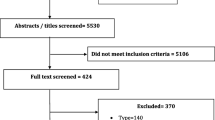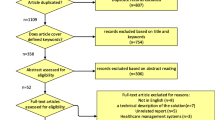Abstract
Purpose
There is a growing population of older people living alone within the context of dramatic population ageing and changing living arrangements. However, little is known about the quality of life (QoL) of older people living alone in Mainland China. This study aimed to investigate QoL and its related factors among Chinese older people who live alone.
Methods
A stratified random cluster sample of 521 community-dwelling older people living alone in Shanghai completed a structured questionnaire through face-to-face interviews. QoL was measured using the Older People’s Quality of Life Questionnaire. Other data collected included self-rated health, physical health, cognitive function, depression, functional ability, loneliness, social support, physical activity, health services satisfaction, satisfaction with overall dwelling conditions and socio-demographic variables.
Results
Older people living alone in Mainland China rated social relationships and financial circumstances as sources of low satisfaction within their QoL. Multiway analysis of variance showed that satisfaction with overall dwelling conditions, self-rated health, functional ability, depression, economic level, social support, loneliness, previous occupation and health services satisfaction were independently related to QoL, accounting for 68.8 % of the variance. Depression and previous occupation had an interaction effect upon QoL.
Conclusions
This study identified nine factors influencing the QoL of older people living alone in Mainland China. Interventions to increase satisfaction with dwelling conditions, improve economic level, social support and functional ability, decrease loneliness and depression and improve health services satisfaction appear to be important for enhancing their QoL.
Similar content being viewed by others
References
United Nations. (2009). World population ageing 2009. New York: United Nations.
United Nations. (2001). World population ageing: 1950–2050. New York: United Nations.
World Health Organization. (2008). WHO global report on falls prevention in older age. Geneva: World Health Organization.
Rolls, L., Seymour, J. E., Froggatt, K. A., & Hanratty, B. (2010). Older people living along at the end of life in the UK: Research and policy challenges. Palliative Medicine, 25(6), 650–657.
Casey, B., & Yamada, A. (2002). Getting older, getting poorer? A study of the earnings, pensions, assets and living arrangements of older people in nine countries. OECD labour market and social policy occasional papers, no. 60, OECD Publishing. http://dx.doi.org/10.1787/345816633534. Accessed March 24, 2013.
Chou, K. L., & Chi, I. (2000). Comparison between elderly Chinese living alone and those living with others. Journal of Gerontological Social Work, 33(4), 51–66.
Lee, J. J. (2005). An exploratory study on the quality of life of older Chinese people living alone in Hong Kong. Social Indicators Research, 71(1–3), 335–361.
Lin, P. C., Yen, M. F., & Fetzer, S. J. (2008). Quality of life in elders living alone in Taiwan. Journal of Clinical Nursing, 17(12), 1610–1617.
World Health Organization. (1977). Prevention of mental disorders in the elderly. Copenhagen: World Health Organization.
Bowling, A. (2009). The psychometric properties of the Older People’s Quality of Life Questionnaire, compared with CASP-19 and the WHOQOL-OLD. Current Gerontology and Geriatrics Research. doi:10.1155/2009/298950.
World Health Organization. (2002). Active ageing. A policy framework. Geneva: World Health Organization.
Yahaya, N., Abdullah, S. S., Momtaz, Y. A., & Hamid, T. A. (2010). Quality of life of older Malaysians living alone. Educational Gerontology, 36(10–11), 893–906.
Bilotta, C., Bowling, A., Nicolini, P., Case, A., & Vergani, C. (2012). Quality of life in older outpatients living alone in the community in Italy. Health and Social Care in the Community, 20(1), 32–41.
The WHOQOL Group. (1995). The World Health Organization quality of life assessment (WHOQOL): Position paper from the World Health Organization. Social Science and Medicine, 41(10), 1403–1409.
Chen, Z. L., & Chen, X. B. (2006). Discussion on situation of the ageing in Shanghai and its countermeasures. Chinese Health Service Management, 22(11), 671–673.
Zhang, L. (2010). Shanghai coming to grip with its aging population problems. EAI background brief, no. 517. http://www.eai.nus.edu.sg/BB517.pdf. Accessed August 30, 2013.
Gerontological Society of Shanghai. (2011). 2010 Shanghai monitored statistical information on population of the elderly & development of old age program. http://www.shanghaigss.org.cn/news_view.asp?newsid=7892. Accessed August 30, 2013.
National Bureau of Statistics of China. (2011). Major figures of the sixth national population census. http://www.stats.gov.cn/zgrkpc/dlc/yw/t20110428_402722384.htm. Accessed August 30, 2013.
Newton, R. R., & Rudestam, K. E. (1999). Your statistical consultant: Answers to your data analysis questions. California: Sage.
Pfeiffer, E. (1975). A Short Portable Mental Status Questionnaire for the assessment of organic brain deficit in elderly patients. Journal of American Geriatric Society, 23(10), 433–441.
Chen, Y., Hicks, A., & While, A. E. (2013). Validity and reliability of the modified Chinese version of the Older People’s Quality of Life Questionnaire (OPQOL) in older people living alone in China. International Journal of Older People Nursing. doi:10.1111/opn.12042.
Chen, Y., Hicks, A., & While, A. E. (2013). Quality of life of older people in China: A systematic review. Reviews in Clinical Gerontology, 23(1), 88–100.
Sheikh, J. L., & Yesavage, J. A. (1986). Geriatric Depression Scale (GDS): Recent evidence and development of a shorter version. Clinical Gerontologist, 5(1–2), 165–173.
Boey, K. W. (2000). The use of GDS-15 among the older adults in Beijing. Clinical Gerontologist, 21(2), 49–60.
Lawton, M. P., & Brody, E. M. (1969). Assessment of older people: Self-maintaining and instrumental activities of daily living. The Gerontologist, 9(3), 179–186.
Russell, D. W. (1996). UCLA Loneliness Scale (version 3): Reliability, validity, and factor structure. Journal of Personality Assessment, 66(1), 20–40.
Xiao, S. Y. (1999). The Social Support Rate Scale. In X. D. Ma, X. L. Wang, & H. Ma (Eds.), The handbook of Mental Health Rating Scales (pp. 127–131). Beijing: Chinese Mental Health Journal Press.
Haskell, W. L., Lee, I. M., Pate, R. R., Powell, K. E., Blair, S. N., Franklin, B. A., et al. (2007). Physical activity and public health: Updated recommendation for adults from the American College of Sports Medicine and the American Heart Association. Medicine and Science in Sports and Exercise, 39(8), 1423–1434.
Polit, D. F., & Beck, C. T. (2012). Nursing research: Generating and assessing evidence for nursing practice (9th ed.). Philadelphia: Lippincott Williams & Wilkins.
Tabachnick, B. G., & Fidell, L. S. (2001). Using multivariate statistics (4th ed.). New York: Allyn and Bacon.
Zhong, R. Y. (2004). An analysis of the living condition of the elders living alone in Shanghai and the policy related. Journal of Social Science, 8, 66–70.
Tong, H. M., Lai, D. W. L., Zeng, Q., & Xu, W. Y. (2011). Effects of social exclusion on depressive symptoms: Elderly Chinese living alone in Shanghai. China. Journal of Cross-Cultural Gerontology, 26(4), 349–364.
Phillips, D. R., Siu, O. L., Yeh, A. G. O., & Cheng, K. H. C. (2005). The impacts of dwelling conditions on older persons’ psychological well-being in Hong Kong: The mediating role of residential satisfaction. Social Science and Medicine, 60(12), 2785–2797.
Michalos, A. C., Zumbo, B. D., & Hubley, A. (2000). Health and the quality of life. Social Indicators Research, 51(3), 245–286.
Lee, T. W., Ko, I. S., & Lee, K. J. (2006). Health promotion behaviors and quality of life among community-dwelling elderly in Korea: A cross-sectional survey. International Journal of Nursing Studies, 43(3), 293–300.
Zhang, J. P., Huang, H. S., Ye, M., & Zeng, H. (2008). Factors influencing the subjective well being (SWB) in a sample of older adults in an economically depressed area of China. Archives of Gerontology and Geriatrics, 46(3), 335–347.
Paskulin, L., Vianna, L., & Molzahn, A. E. (2009). Factors associated with quality of life of Brazilian older adults. International Nursing Review, 56(1), 109–115.
Jia, S. M., Feng, Z. Y., Hu, Y., & Wang, J. Q. (2004). Survey of the living quality and its effect factors for the aged people in urban community of Shanghai city. Journal of Nurses Training, 19(5), 420–423.
Zhou, B., Chen, K., Wang, J. F., Wang, H., Zhang, S. S., & Zheng, W. J. (2011). Quality of life and related factors in the older rural and urban Chinese populations in Zhejiang Province. Journal of Applied Gerontology, 30(2), 199–225.
Cai, T. J. (2004). Self-rated life satisfaction and its determinants among Chinese elderly females living alone. Chinese Journal of Population Science, S1, 70–74.
Deng, J. L., Hu, J. M., Wu, W. L., Dong, B. R., & Wu, H. M. (2010). Subjective well-being, social support, and age-related functioning among the very old in China. International Journal of Geriatric Psychiatry, 25(7), 697–703.
Huang, J. Q., Chen, Q. E., & Shu, X. F. (2005). A study on the relationship between quality of life and social support of elder in community. Chinese Journal of Behavioral Medicine Science, 14(8), 725–726.
Xiao, S. Y. (1994). The theoretical basis and applications of Social Support Rate Scale. Journal of Clinical Psychiatry, 4(2), 98–100.
Fratiglioni, L., Wang, H. X., Ericsson, K., Maytan, M., & Winblad, B. (2000). Influence of social network on occurrence of dementia: A community-based longitudinal study. The Lancet, 355(9212), 1315–1319.
Lauder, W., Sharkey, S., & Mummery, K. (2004). A community survey of loneliness. Journal of Advanced Nursing, 46(1), 88–94.
Victor, C., Scambler, S., Bond, J., & Bowling, A. (2000). Being alone in later life: Loneliness, social isolation and living alone. Reviews in Clinical Gerontology, 10(4), 407–417.
Ruggeri, M., Nose, M., Bonetto, C., Cristofalo, D., Lasalvia, A., Salvi, G., et al. (2005). Changes and predictors of change in objective and subjective quality of life: Multiwave follow-up study in community psychiatric practice. The British Journal of Psychiatry, 187, 121–130.
Joseph, C., & Nichols, S. (2007). Patient satisfaction and quality of life among persons attending chronic disease clinics in South Trinidad, West Indies. The West Indian Medical Journal, 56(2), 108–114.
Brett, C. E., Gow, A. J., Corley, J., Pattie, A., Starr, J. M., & Deary, I. J. (2012). Psychosocial factors and health as determinants of quality of life in community-dwelling older adults. Quality of Life Research, 21(3), 505–516.
Chachamovich, E., Fleck, M., Laidlaw, K., & Power, M. (2008). Impact of major depression and subsyndromal symptoms on quality of life and attitudes towards aging in an international sample of older adults. The Gerontologist, 48(5), 593–602.
Chou, K. L., & Chi, I. (1999). Determinants of life satisfaction in Hong Kong Chinese elderly: A longitudinal study. Aging & Mental Health, 3(4), 328–335.
Chen, Y., Hicks, A., & While, A. E. (2012). Depression and related factors in older people in China: A systematic review. Reviews in Clinical Gerontology, 22(1), 52–67.
Ning, H. D., Luo, C. S., Zhang, Q. X., Zhu, Y. H., Wu, S. Y., Liang, H. Y., et al. (1999). An epidemiological study on quality of life among elderly population in Shenzhen. Chinese Journal of Prevention and Control of Chronic Non-communicable Diseases, 7(4), 1–5.
Qian, Z. C., & Zhou, M. (2004). Social support and quality of life: China’s oldest-old. http://paa2005.princeton.edu/papers/51243. Accessed September 13, 2012.
Acknowledgments
The authors would like to thank Professor Yan Hu and Professor Hai-ou Xia for their translation of the OPQOL and Mr. Peter Milligan for his advice on statistical analysis. We thank data collectors for their assistance in data collection and the older people for their participating in this study. The authors would also like to thank China Scholarship Council, King’s College London and Fudan University for their financial support.
Author information
Authors and Affiliations
Corresponding author
Rights and permissions
About this article
Cite this article
Chen, Y., Hicks, A. & While, A.E. Quality of life and related factors: a questionnaire survey of older people living alone in Mainland China. Qual Life Res 23, 1593–1602 (2014). https://doi.org/10.1007/s11136-013-0587-2
Accepted:
Published:
Issue Date:
DOI: https://doi.org/10.1007/s11136-013-0587-2




